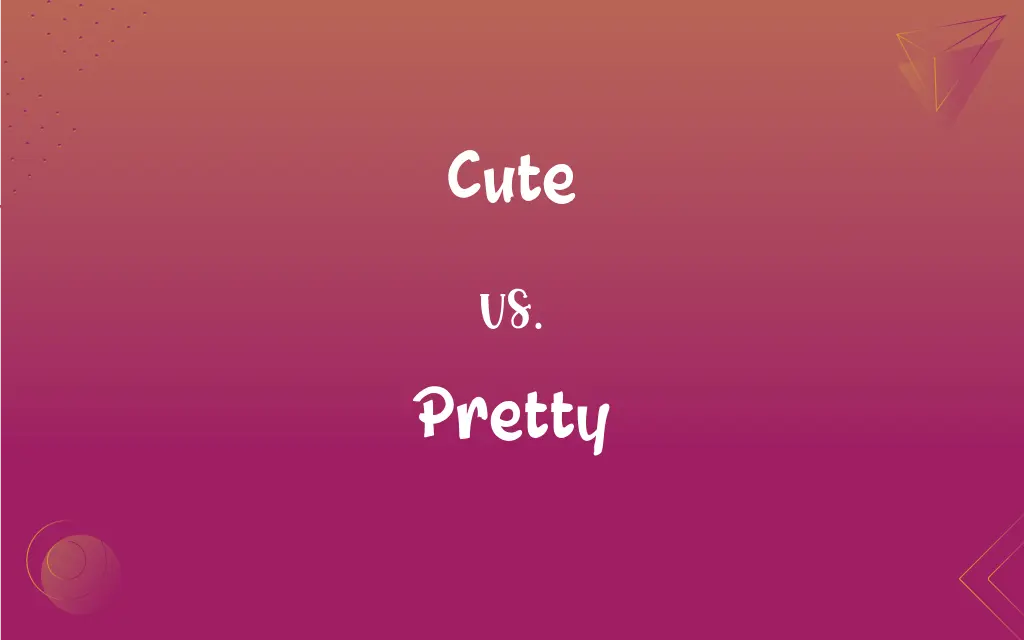Cute vs. Pretty: What's the Difference?
Edited by Janet White || By Harlon Moss || Updated on October 5, 2023
"Cute" often implies a sense of charming, adorable, or endearing qualities, while "pretty" typically refers to a pleasing, attractive, or beautiful appearance.

Key Differences
The word cute implies attributes that evoke feelings of warmth, affection, and a possible sense of vulnerability. People or things labeled as cute often project characteristics that are endearing and charming. On the contrary, pretty is a term frequently utilized to describe an aesthetic appeal that adheres to conventional standards of beauty, often signifying that something or someone is visually attractive without implying deeper emotional involvement.
In a context where one might describe something as cute, the focus may center on the emotions it evokes rather than just the visual appreciation. Kittens, with their clumsy yet coordinated movements, are frequently dubbed cute due to the emotional response they induce. Pretty, however, often leans towards a somewhat superficial admiration, emphasizing visual appeal. A well-arranged bouquet can be described as pretty, appreciating its visual charm without an emotional undertone.
Cute is often utilized to describe qualities that blend a mix of innocence, playfulness, and charm. A child mispronouncing a word might be considered cute because it blends innocence with unintentional humor. Conversely, pretty often lacks the contextual depth, predominantly focusing on surface-level attractiveness. A painting might be deemed pretty if it provides aesthetic pleasure and visual harmony.
Applying cute and pretty to non-living things can also vary in connotation. A cute decor item may imply a quirky, unique, or thematic aesthetic, often evoking a cheerful response. A pretty decor item would probably be visually appealing, elegant, and likely adhering to a more traditionally accepted form of beauty.
Both cute and pretty carry positive connotations but diverge significantly in emotional depth and the type of appreciation they invoke. Cute commonly draws an emotional or nurturing response, while pretty is firmly rooted in aesthetic appreciation, often free from emotional associations.
ADVERTISEMENT
Comparison Chart
Emotional Involvement
Often involves emotional response
Largely aesthetic
Typical Applications
More versatile in usage
Generally applied to visual appeal
Implied Depth
Can imply depth & endearment
Tends to be superficial
Applicability to Age
Can be applied broadly
Often not associated with age
Common Associations
Innocence, charm
Beauty, elegance
ADVERTISEMENT
Cute and Pretty Definitions
Cute
Cute can depict something as quaint or charmingly unusual.
The cute boutique on the corner always drew her attention.
Pretty
Pretty can be used to describe something that pleases the senses in a mild way.
She hummed a pretty melody while cooking.
Cute
Cute might describe something miniature or diminutive in a pleasing way.
She wore a cute little hat tilted to one side.
Pretty
Pretty describes something as visually attractive in a delicate or elegant way.
The garden looked pretty in the morning light.
Cute
Cute implies a charming and somewhat endearing quality.
The puppy’s cute antics had everyone smiling.
Pretty
Pretty may denote a modest or slight degree of a quality.
He was pretty skilled at fixing things around the house.
Cute
Cute can describe something that is cleverly designed or inventive.
What a cute idea to use mason jars as vases!
Pretty
Pretty often alludes to conventional or traditional beauty.
The pretty painting was a harmonious blend of colors.
Cute
Cute often relates to the vulnerable or innocent appearance of living beings.
The baby’s cute giggles melted hearts.
Pretty
Pretty can describe something as neat and orderly.
The pretty arrangement of books was pleasing to the eye.
Cute
Attractive or pretty in a youthful or dainty way
A cute puppy.
A child wearing a cute outfit.
Pretty
Pleasing or attractive in a graceful or delicate way.
Cute
Obviously contrived to charm; precious
"[He] mugs so ferociously he kills the humor—it's an insufferably cute performance" (David Ansen).
Pretty
Clever; adroit
A pretty maneuver.
Cute
Clever or witty, especially in an impertinent or evasive way, as in falsely suggesting that one is ignorant about the matter at hand.
Pretty
Very bad; terrible
In a pretty predicament.
A situation that has reached a pretty pass.
FAQs
Is "cute" applicable to non-living things?
Yes, "cute" can describe objects, ideas, or actions that are charming or clever, such as a cute dress or a cute concept.
Is "cute" used for specific age groups?
No, "cute" can be used to describe people or things of any age, often emphasizing charm or adorableness.
Can "pretty" be used to describe males?
Yes, while traditionally used for females, "pretty" can describe males, but it might carry connotations of delicacy or femininity.
How does "pretty" differ when describing objects?
"Pretty" often implies aesthetic pleasure, like a pretty design, focusing on visual appeal without necessarily invoking emotional response.
Does "pretty" imply superficiality?
Not necessarily, but "pretty" often focuses on surface-level aesthetics without implying deeper qualities.
Can "cute" and "pretty" be used interchangeably?
While both are compliments, "cute" often implies endearing or adorable qualities, while "pretty" denotes conventional attractiveness.
Is "cute" always a compliment?
Generally yes, but context matters. "Cute" can be patronizing if used to diminish someone's maturity or seriousness.
Does "pretty" have different meanings in informal language?
Yes, informally, "pretty" can indicate to a moderate degree, like "It’s pretty cold outside."
Can "cute" describe a style or trend?
Absolutely, "cute" can characterize styles or trends that emphasize playfulness, charm, or quaintness.
Can "pretty" describe abstract concepts?
It can, especially in informal contexts. For instance, "a pretty chance" refers to a considerable likelihood.
Can animals be described as "cute" or "pretty"?
Yes, animals can be "cute" due to their endearing characteristics or "pretty" due to their visual appeal.
Can "cute" describe an action or behavior?
Yes, actions can be "cute" if they’re endearing or evoke a warmth, like a child’s innocent mischief.
Can an idea be "cute"?
Yes, "cute" can describe ideas that are clever and charming, though sometimes it might imply simplicity or impracticality.
Can "cute" be used in a professional context?
While possible, using "cute" in professional contexts may be perceived as informal or diminutive.
Does "pretty" always refer to physical appearance?
Not always. "Pretty" can also describe a considerable degree when used informally, like "pretty good" or "pretty difficult."
Is "pretty" applicable to sensory experiences outside of sight?
Yes, while commonly visual, "pretty" can describe any mild, pleasing sensory experience, like a "pretty melody."
Does "pretty" carry cultural connotations?
Yes, perceptions of what is "pretty" can be influenced by cultural standards of beauty and aesthetics.
Is "cute" used differently in various regions or countries?
Yes, cultural and regional variations can affect how "cute" is perceived or utilized in language.
Can "pretty" be objective?
"Pretty" often involves personal or cultural bias, as beauty standards can be subjective and variable.
How does "cute" relate to fashion?
In fashion, "cute" often pertains to styles that are playful, youthful, and charming, perhaps with a whimsical element.
About Author
Written by
Harlon MossHarlon is a seasoned quality moderator and accomplished content writer for Difference Wiki. An alumnus of the prestigious University of California, he earned his degree in Computer Science. Leveraging his academic background, Harlon brings a meticulous and informed perspective to his work, ensuring content accuracy and excellence.
Edited by
Janet WhiteJanet White has been an esteemed writer and blogger for Difference Wiki. Holding a Master's degree in Science and Medical Journalism from the prestigious Boston University, she has consistently demonstrated her expertise and passion for her field. When she's not immersed in her work, Janet relishes her time exercising, delving into a good book, and cherishing moments with friends and family.































































